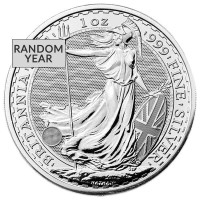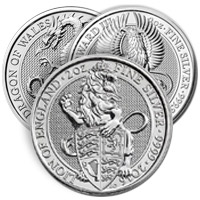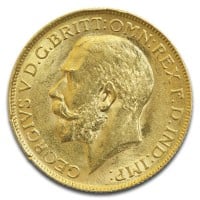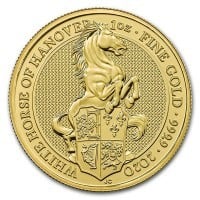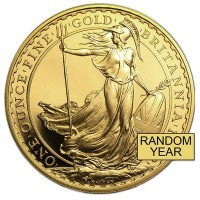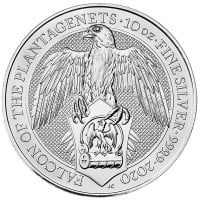The Royal Mint - British Gold & Silver Coins

History
While Britain has used coins since around 200BC, the Royal Mint began over 1100 years ago in 886AD. Before that point, Britain saw numerous battles over who would produce currency in London, as different rulers fought over territory in the area.
Even after 886AD, it took nearly 400 years before the Tower of London consolidated coin production into one facility. Here, the master-worker and others who could legally and officially create coins ran the mint until they began to outgrow it. During the English Civil War of the 1630s, the Tower set up branch mints to accommodate the demand for currency.
In 1812, London finished construction on a new mint, built on Tower Hill, which they later named the Royal Mint. In 1852, the Royal Mint bought the premises next door using the name “the Royal Mint Refinery,” creating more space and machinery.
During World War II, the Royal Mint produced currency to pay workers in place of banknotes. At that point, it began producing double its usual output while the basement functioned as an air raid shelter until the war’s end in 1944.
In 1967, the Royal Mint relocated away from the Royal Mint Court, its original location. As the Royal Mint expanded with higher production rates and new equipment, it moved to Wales, where it still resides today, operating under Royal Mint, Limited.
Operations
The Royal Mint’s services include producing bullion, coins, and medals, such as those for the 2012 London Olympics. It makes currency for approximately 60 countries throughout the United Kingdom and other parts of the world, including New Zealand.
The Royal Mint bears the responsibility to mint coins for circulation, as well as those intended for coin collecting. They produce all of the currency throughout the UK, which amounts to about 2 billion pound sterling coins each year.
The facility produces coins for export mint purposes, too. It creates over 2 billion coins for international use each year—even more than the amount of minted coin for the UK alone.
When it comes to bullion, the Royal Mint produces both bars and coins. While it has produced bullion since 1852, it started producing bullion coins in 1957 after purchasing the Royal Mint Refinery, in response to the high demand for sovereign coins.
For a while, it stopped producing bullion bars, though production began again in 2015. Now, its bullion bars all bear the Royal Mint Refinery emblem. Gold bars all have 0.9999 fineness, and silver bars contain 0.999.
Popular Products
Over the years, the Royal Mint has produced some of the most popular silver and gold coins across the world. Many investors collect royal coins, and the history of the Royal Mint, along with its renowned quality, makes it a top contender for collectible coins.
Some of its most well-known and high-demand products include:
- Britannia Coins: Originally, the Royal Mint made their Britannia Coins with gold. However, in 1997, ten years after it made the first Britannia, they made a silver coin as part of the same collection. Silver Britannia Coins use 0.999 fine silver—finer than the original 0.958 fineness—and gold coins have 0.9999 fineness
- Gold Sovereign Coins: The Royal Mint’s Sovereign Gold Coin remains the most identifiable gold currency across the world today. As a bullion coin, it holds more value in coin collecting than spending currency, and even non-collectors usually recognize its brilliance
- British Queen’s Beasts: In 2016, the Royal Mint released this series depicting engravings modeled after the ten beasts of the Queen’s Beasts statues that represented the Queen’s guard
- Lunar Series: The Royal Mint began their Chinese Zodiac Lunar Series in 2014 with the year of the horse. They have since released one new coin each year. These coins have been sought-after by collectors worldwide
The Royal Mint has several coin collections, coveted by investors and collectors alike. Many of their series release annually, but they also have sovereign coins and accessories like cufflinks available.
Trial of the Pyx
In the United Kingdom, the Trial of the Pyx takes place throughout the year. The trial ensures that each coin the Royal Mint produces meets the standard for newly minted coins. It ensures the production of identical coins of the same weight and fineness.
The name of the trial comes from the word pyx, a specific type of boxwood chest. In the early years of the trials, this chest was used to hold the coins the jury would sample.
This trial began in 1282 when a Master of the Mint would select one coin from every ten pounds of minted silver. This duty now falls to the Deputy Master of the Mint, who chooses a coin from each type produced.
Now, the Trial of the Pyx involves sampling thousands of coins per year. Each type of coin has different regulations. Some, like Maundy money, require one coin taken out of every 150 produced, while others call for only one in 5,000 minted coins.
Each coin has its own guidelines that range from information about their size and shape to its chemical makeup and content of each type of metal. Over two months, a jury tests the coins to ensure each one is identical to the rest.
Conclusion
Royal Mint Limited produces coins distributed across the UK and throughout the world. Its services range from providing bullion to minting coins meant for circulation and collecting.
As the world’s leading export mint, it has provided information about coins, bullion, medals, and more. It has made history as a producer of currency and an institution that sets the standard for coins and bullion.
While the institution itself has changed over more than 1100 years, its purpose remains the same. The Royal Mint continues to circulate currency while creating pieces that allow investors to expand their portfolios and invest in metals.
For more information, the Royal Mint’s Information Library has resources detailing their services and the types of coins they produce for worldwide markets. It also contains case studies for coin reclamation, security features, currency integrity, and more.




